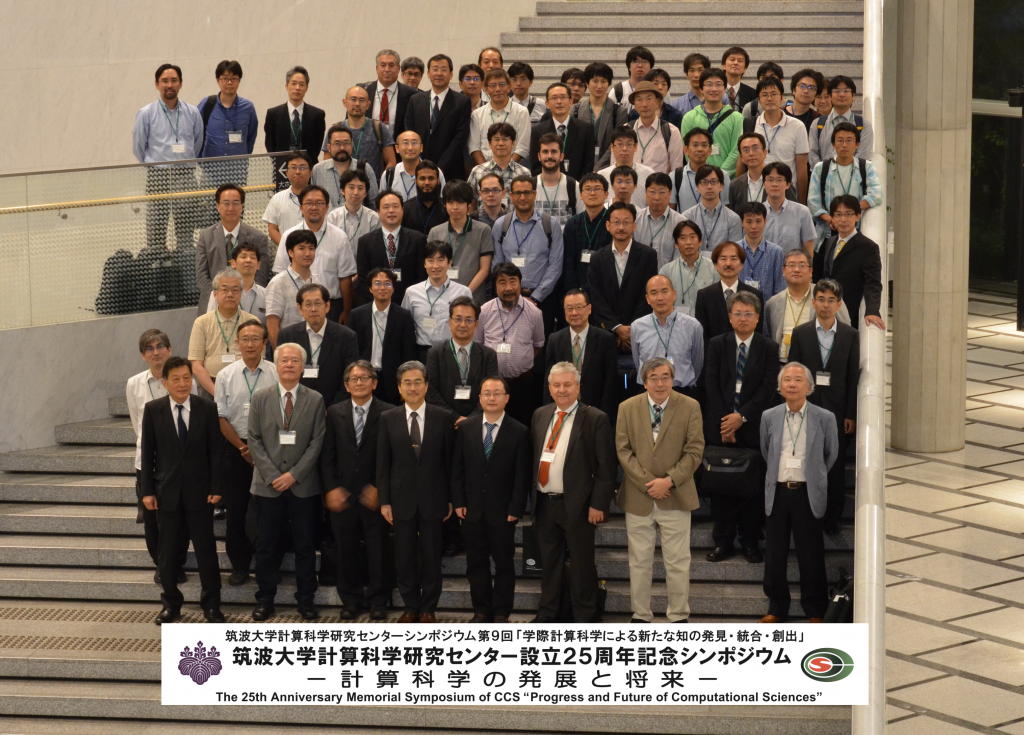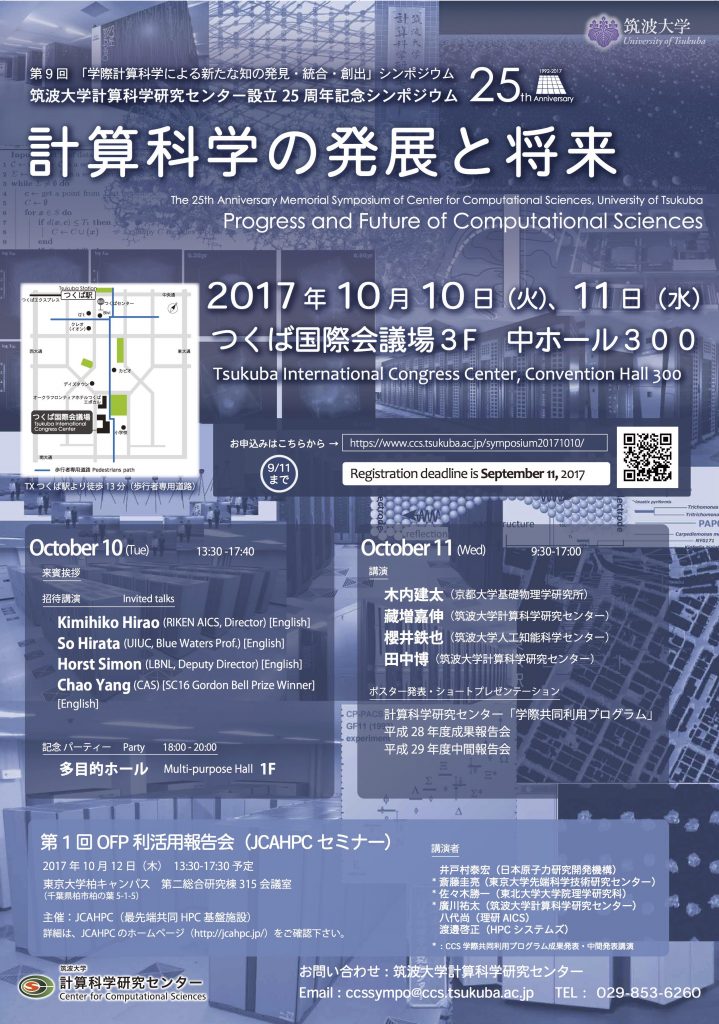Dates and Venues / Registration / Program / Access information
The 25th Anniversary Memorial Symposium of CCS, Univ. Tsukuba “Progress and Future of Computational Sciences”
Today, computational science is an indispensable research methodology in the basic and applied sciences, and contributes significantly to the progress of a wide variety of scientific research fields. For multidisciplinary computational science based on the fusion of computational and computer sciences, frequent/regular opportunities of communication and collaboration are essential. Center for Computational Sciences (CCS) at University of Tsukuba, which started as Center for Computational Physics at 1992 and reorganized at 2004, aims at improving such collaborations between different research fields. In 2010, the CCS was recognized under the Advanced Interdisciplinary Computational Science Collaboration Initiative (AISCI) by MEXT, and has since provided the use of its computational facilities to researchers nationwide as part of the Multidisciplinary Joint-use Program. For celebrating the 25th anniversary since start of the CCS and for reporting recent results of the Multidisciplinary Joint-use Program, this symposium is held at Tsukuba International Congress Center.
Dates and Venues
Dates:10 Oct. [Tue] 13:30 - 11 Oct. [Wed] 17:00
Venue:Tsukuba International Congress Center “Hall 300”
Program
10 Oct. [*Talk is given in English]
| 13:30 – 14:00 | Congratulatory address | |
| Chair: Takashi Nakatsukasa (Univ. Tsukuba) | ||
| 14:00 – 14:50 |
“Ten Years of Exascale – Are We There Yet?” * |
Horst Simon |
| 14:50 – 15:40 |
“From K to Post K |
Kimihiko Hirao (RIKEN AICS, Director) |
| 15:40 – 16:00 | Break | |
| Chair: Yasuteru Shigeta (Univ. Tsukuba) | ||
| 16:00 – 16:50 |
“Symbolic computing and supercomputing in chemistry” * |
So Hirata (UIUC, Blue Waters Prof.) |
| 16:50 – 17:40 | “Scaling Fully Implicit PDE Solvers to 10M Cores” * | Chao Yang (CAS) |
| 18:00 – 20:00 | 25th Anniversary Party (at Multi-Purpose Hall) | |
11 Oct. [All presentations are in Japanese]
| Chair: Hiroyasu Koizumi (Univ. Tsukuba) | ||
| 9:30 – 10:05 |
「大気大循環の3次元エネルギースペクトルの研究」 |
Hiroshi L. Tanaka |
| 10:05 – 10:35 | Short Presentation(1.5min x 20) | |
| 10:35 – 11:00 | Break | |
| 11:00 – 11:35 | 「Oakforest-PACSが切り拓く新たな格子QCDシミュレーションの展開」 | Yoshinobu Kuramashi (Univ. Tsukuba) |
| 11:35 – 12:05 | Short Presentation(1.5min x 20) | |
| 12:05 – 13:15 | Lunch | |
| Chair: Osamu Tatebe (Univ. Tsukuba) | ||
| 13:15 – 13:45 | Short Presentation(1.5min x 20) | |
| 13:45 – 15:15 | Poster session | |
| 15:15 – 15:50 |
「連星中性子星合体の数値モデリングと重力波」 |
Kenta Kiuchi (Univ. Kyoto) |
| 15:50 – 16:25 | 「Oakforest-PACSによる大規模非線形固有値問題の高性能計算」 | Tetsuya Sakurai (Univ. Tsukuba) |
Registration
Participants should fill out the registration form at https://www2.ccs.tsukuba.ac.jp/cgi-bin/sympo201710/form.cgi by September 26th, 2017. The registration is free, and the party fee is 5,000 JPY.
Access information
– From airports to Tsukuba Center
There are two airports, Narita and Haneda, in the Tokyo area. For the access to Tsukuba, Narita Airport is more convenient than Haneda. The direct highway bus to Tsukuba from Narita airport is available roughly every hour, and it takes about one hour. From Haneda airport, there are also direct bus to Tsukuba, but the service is less frequent and it takes about two hours.
– From Tokyo to Tsukuba Center
Rapid trains of Tsukuba Express (TX) Line bring you to Tsukuba station from Akihabara station in Tokyo in 45 minutes. See the following maps:
* Tsukuba Express Line (http://www.mir.co.jp/en/route_map/index.html)
* Tokyo Metro (http://www.tokyometro.jp/en/subwaymap/)
– To International Congress Center Epochal Tsukuba ( https://www.epochal.or.jp/eng/access/map_shuhen.html)
Abstract
“Ten Years of Exascale – Are We There Yet?”
The first set of exascale workshops were held ten years ago in the Spring of 2007. Very quickly it was recognized that reaching the next big performance level in high performance computing is not just a matter of scaling, but that fundamental breakthroughs in architecture, software, algorithms, and application were required. But at the time and very optimistically 2018 seemed to be the year exascale was achievable. In the years from 2008 to 2010 more workshops refined the path towards exascale computing in the U.S., and by about 2010 delivered the outline of a plan on how to achieve this goal. Also internationally several countries developed exascale initiatives. So all indicators were positive. Yet now, ten years later in the second half of 2017, we are still about five years away from exascale and 2023 seems to be a more likely target. What happened? I will revisit the original goals and projections, and analyze where and when the community started to fall behind. This will be a useful analysis to draw lessons for the next five years, and see how exascale computing can eventually be achieved.


 [Poster PDF]
[Poster PDF]